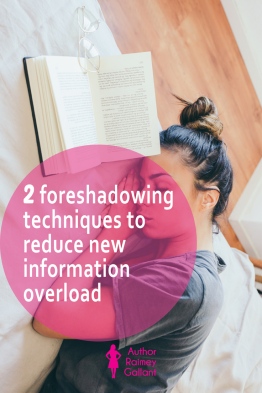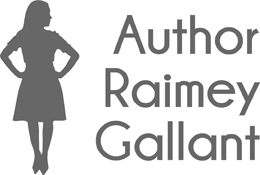
Reading a book is like jumping on an exercise bike for the brain. The reason is because every sentence is a piece of information the reader needs to process. Some sentences are easier to absorb than others. For instance, a sentence that speaks about characters, themes, and plots the reader has already gotten to know doesn’t require as much processing as a sentence introducing new characters, sub-themes, or subplots. We want readers to keep pedaling and processing this new information, but as so often happens in books, there comes a point when the reader decides to take a break. It could be because life calls (the kids need a referee, time to finish that thesis, etc.), but it’s often because the book is asking the reader to absorb new information either at too rapid a pace or without adequate incentive to continue doing so. Here are two foreshadowing techniques to ease readers into new information (including but not limited to new characters, sub-themes, and subplots.)
TECHNIQUE 1: THE CARROT A technique you’ll be familiar with is the cliff-hanger chapter ending. Here are two potential formulas:
- CARROT DANGLED AT CHAPTER END + REWARD AT NEW CHAPTER BEGINNING = INCENTIVE TO CONTINUE READING
or
- CARROT DANGLED AT CHAPTER END + DELAYED REWARD = INCENTIVE TO CONTINUE READING
I’d like to talk about the second formula. What may not be obvious is that there’s an opportunity to load this formula with new information (perhaps the introduction of a new character or subplot) while retaining reader interest, because they’re after that carrot. Now take a look at the formula with this added bit of technique.
CARROT DANGLED AT CHAPTER END + NEW INFORMATION + DELAYED REWARD = INCENTIVE TO CONTINUE READING
But wait, she’s not finished. That’s right, folks, I’m going to alter the formula one last time, because this technique is not limited to chapter or scene endings.
CARROT DANGLED + NEW INFORMATION + DELAYED REWARD = INCENTIVE TO CONTINUE READING.
Now here’s a quick example from my own work in progress. I’ve pared it down so you can see the carrot dangled right before a new character is introduced.
“Don’t even try it,” Louise said. “You know I can’t talk about the case. Besides, there haven’t been any developments since that dog thing yesterday afternoon, so I couldn’t tell you anything if I wanted to.”
“What dog thing?” [CARROT DANGLED]
Louise’s face crinkled in all the places guilt made a face crinkle. “I thought you knew.”
“Hey!”
Ally and Louise craned up to the origin of the interruption. A girl was straddling the gabled roof of the house’s dormer, her waving hand a propeller of enthusiasm. [NEW CHARACTER INTRODUCTION]
“Hey!” she said again, and the object balancing before her skidded down the shingles and dropped with a thud on the asphalt.
Ally sidestepped a ripe pile of compost in the middle of the driveway and picked up the fallen textbook, split up the spine, a fleshy representation of the musculoskeletal system on the jacket.
 TECHNIQUE 2: THE TASTE Time to switch analogies. Think of these new pieces of information like a dish you’ve never tried. Are you going to heap your spoon and load your mouth, or are you going to taste it before you commit? The pre-taste is kind of like foreshadowing. Before loading up a reader’s spoon with a new subplot, for instance, perhaps you could offer them a little taste, a brief mention a chapter or two ahead, a warning that heads up, this new subplot is about to come into the story. Then by the time you delve into the subplot, they’ve been waiting for it, and they’re ready.
TECHNIQUE 2: THE TASTE Time to switch analogies. Think of these new pieces of information like a dish you’ve never tried. Are you going to heap your spoon and load your mouth, or are you going to taste it before you commit? The pre-taste is kind of like foreshadowing. Before loading up a reader’s spoon with a new subplot, for instance, perhaps you could offer them a little taste, a brief mention a chapter or two ahead, a warning that heads up, this new subplot is about to come into the story. Then by the time you delve into the subplot, they’ve been waiting for it, and they’re ready.
This post is part of the #AuthorToolboxBlogHop. So many great blogs to keep hopping through. Click here to join the hop and to see what other writing tips you can glean from this month’s edition.
Can you think of any other ways to ease readers into new information? In your own writing, have you used either of these techniques before? Chat with me in the comments.


I’ve used both styles. I try to drop some info within the current chapter, but I’ve also used it at the end. Unless the “carrot” is immediate and needs to be addressed, I like to add to that at least one more time before I come back and solve the conflict/idea/carrot eating.
Stu
Tale Spinning
https://stuartnager.wordpress.com/
LikeLiked by 1 person
Super interesting. 🙂 I’ll be visiting back soon!
LikeLiked by 1 person
…and it’s fun to make that dangled carrot a surprise for the reader 🙂
LikeLiked by 1 person
Indeed. 🙂
LikeLike
Great tips. I enjoyed reading your example of the carrot in the middle of the chapter.
LikeLiked by 1 person
Thanks Natalie! I was worried I was making it too convoluted. Phew! At least people get it. 🙂
LikeLike
Love the dangling carrot techniques.
LikeLiked by 1 person
Thanks, Pam!
LikeLiked by 1 person
I’m always afraid the clever foreshadowing I’m slyly sliding into a conversation will be totally missed. Ah well.
LikeLiked by 1 person
I think if it is, then that’s great. If you can weave in something that only hits the reader’s subconscious, then at least it’s still there, and they’ll be happy when you do address it. They’ll get the reward they didn’t even know they were waiting for. 🙂
LikeLike
Those work well. Certainly you can’t dump a bunch on them. But if you can keep them turning pages, that’s a big bonus.
LikeLiked by 1 person
I was just saying that to someone, that I feel like maybe I need to go back over some of my older posts (including this one), and add disclaimers (exceptions to every rule, use in moderation, that kind of thing.)
LikeLike
Great info. Like the way you structure the info in your post.
LikeLiked by 1 person
Why thank you, Juneta. 🙂
LikeLike
This is a really insightful post. Thank you for sharing. I’ve definitely seen “the taste” before, and the cliffhanger is no stranger to me, but the different “delayed rewards” techniques are easily missed if you’re not looking for them. Posts like this really help me learn to watch for and recognize the techniques that, when done well, become night invisible.
Thank you for posting/sharing.
LikeLiked by 1 person
It is my absolute pleasure. I’m happy you were able to take something away from it. 🙂
LikeLiked by 1 person
I’m glad. I find you have a real knack for insightful posts. Maybe some time you could share a bit about your writing learning/study process, what it looks like, what you feel is critical to developing a greater understanding of writing…
And now that I’ve said it, I think I might write one of those too. I feel like that would be a wonderful mutual sharing experience.
LikeLiked by 1 person
I will definitely ponder that idea. Looking forward to reading your post on the topic!
LikeLiked by 1 person
Nice excerpt 😀
I love the idea of dangling carrots then adding a new character. I think I’ll try and use that in my work in progress.
I’ve used the taste technique before, usually by mentioning a character and their problem in conversation between two other characters before that character is introduced!
LikeLiked by 1 person
I’ve done that too!
LikeLiked by 1 person
Great tips! Love the analogies. 🙂
LikeLiked by 1 person
Thanks so much, Jennifer!
LikeLike
Great tips today. Love the examples. Thanks.
LikeLiked by 1 person
Yea! High praise indeed. Thanks. 🙂
LikeLiked by 1 person
This is a great example. I’ve seen it done SO often in TV shows. An episode ends on a cliffhanger and you breathlessly tune in next week (or next season!) to see the resolution of it–and it doesn’t happen until later in the show! It keeps you watching.
LikeLiked by 1 person
Totally. I’m not ashamed to admit I pick up on techniques from film and TV whenever I can. 🙂
LikeLike
I’m going to go back and see how my WIP stacks up to your different techniques to entice readers to move chapter to chapter. Great post!
LikeLiked by 1 person
Why thank you. 🙂
LikeLike
Great tips. As Megan said, it’s used very successfully in TV. Thanks for sharing 🙂
Ronel visiting from the Author Toolbox blog hop. Latest post at Ronel the Mythmaker
LikeLiked by 1 person
Agreed!
LikeLiked by 1 person
Foreshadowing can be fun if done right. Thanks for the tips. 🙂
Anna from elements of emaginette
LikeLiked by 1 person
Thanks, Anna!
LikeLiked by 1 person
Thanks, Raimey, for the concise informative read about foreshadowing. I’ve shared it online. All best to you!
LikeLiked by 1 person
My pleasure, and all the best to you too!
LikeLike
Great tips! When this is done well, you find yourself finishing the book even if it means staying up way past your bedtime because you can’t stop chasing after those carrots.
LikeLiked by 1 person
Absolutely! Give me a book like that, and I’ll choose reading over sleep every time. 🙂
LikeLike
Foreshadowing means a little something different to me. I interpret it as “foreshadowing” the conclusion or giving a hint to the resolution. I never thought about it as a way to entice readers to keep reading. That’s a new twist for me. I do usually try to end my chapters or my sections with a cliff hanger. The trick is not to put off the reward for too long. Then, it seems forced and readers don’t like that.
Thanks for this new look at foreshadowing.
LikeLiked by 1 person
I thought a long time about which term I should use for this post, but you’re right, foreshadowing can mean something different. Thanks for visiting!
LikeLike
Great formula! I love to use the dangling carrot. Since I write romance, it usually has to do with the “will they/won’t they” question.
LikeLiked by 1 person
Super interesting. 🙂
LikeLiked by 1 person
Cliff-hanger chapter endings are my favorite as a reader and a writer. 🙂
LikeLiked by 1 person
Mine too, but only in retrospect. At the time, I’m like, just tell me already!!! 🙂
LikeLiked by 1 person
Thanks for the breakdown of these two foreshadowing techniques. I love the way you kept building on the formula you gave.
LikeLiked by 1 person
Thanks so much, Erika!
LikeLike
What a great post, Raimey! It actually sparked an idea in my head as I was reading, haha. Thanks for sharing!
LikeLiked by 1 person
Compliment of the day right there. That’s what I’m aiming for. Thanks, Hoda!
LikeLike
I definitely like dangling the carrot at the end of chapters and also adding new information slowly, tiny bit by bit. The more suspense the better, and I definitely as a reader do not not books that end with cliff hangers. 🙂
LikeLiked by 1 person
I meant like instead of an extra not* So sorry for the typo.
LikeLiked by 1 person
We are in agreement!!!!
LikeLiked by 1 person
The carrot dangling technique is a lot of fun and wonderfully timeless.
In the one I’m working on now a lonely man is sitting in a cafe late at night. He spots a child standing outside. She waves and runs through a field of corn. Realizing she’s running straight for the river he runs after her. The chapter ends with him disappearing from existence.
As a reader stuff like that never gets old. It makes me think and of course it makes me turn the page.
The challenge for us writers is to create compelling characters. If the reader cares about them, they’re hooked. But if they’re not, we’re sunk.
Great stuff as always. Thank you!!!
LikeLiked by 1 person
Thanks for sharing. 🙂
LikeLiked by 1 person
Dangling the carrot correctly can be a real sticking point, at least it can be for me. When I write, I’m usually thinking so linearly that I don’t even think about these kinds of things until the second pass. Thanks for the post.
LikeLiked by 1 person
I often don’t catch opportunities to do this kind of thing in my first draft.
LikeLike
I prefer chocolate to carrots …
Seriously, these are useful tips. I know some books do a much better job of keeping me engaged than others, and you’ve hit the nail on the head: I often lose engagement when there is too much plot (or sometimes too much emotion), and I need time to process.
Now, how to incorporate this into my own manuscript to keep the reader reading …
LikeLiked by 1 person
Let it be known, that henceforth, it shall be known as the ‘dangling chocolate technique.’ 🙂
LikeLike
The end of chapters is the hardest part for me. I try to leave a carrot, but I think it often becomes a brussel sprout… I’ll have to try your tips!
LikeLiked by 1 person
I love brussel sprouts. 🙂
LikeLiked by 1 person
I do, too!
LikeLiked by 1 person
Great tip. I loved your example of the dangling carrot and how you broke everything down. I’ll have to think about this and consider how I can incorporate it into my writing.
LikeLiked by 1 person
Thanks so much, Mandy!
LikeLike
Brilliant advice! Love your formula! And great analogy 😀
LikeLiked by 1 person
Merci!
LikeLiked by 1 person
I keep reading craft books trying to learn how to do clever carrot dangling because as you say that is the best way to hook a reader into keep turning the pages!
LikeLiked by 1 person
All in moderation, but I’ve found it keeps me turning pages. 🙂
LikeLike
This is such a major writing problem–I know it drives me nuts in books and films. Thanks for sharing this important advice!
LikeLiked by 1 person
I’m giddy you like it. 🙂
LikeLiked by 1 person